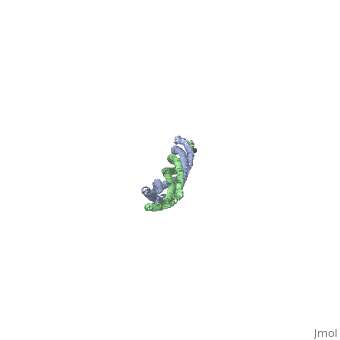Molecular Playground/Cytoplasmic domain of chemoreceptor of Thermotoga maritima
From Proteopedia
One of the CBI Molecules being studied in the University of Massachusetts Amherst Chemistry-Biology Interface Program at UMass Amherst and on display at the Molecular Playground.
Contents |
Cytoplasmic Domain of chemoreceptor of Thermotoga maritima
IntroductionBacteria use their receptors to sense the environment to change their swimming patterns. There are different kinds of chemoreceptors that respond to different stimuli. The figure on the right is the cytoplasmic domain of chemoreceptor of Thermotoga maritima. Bacteria like to flee away from the repellent when high concentrations are present in the environment. CheA is a histidine kinase that associates with CheW, an adaptor protein, will cause the flagella to turn clockwise and result in a tumbling motion. On the other hand, when a high concentration of attractants are present in the environment, the CheA kinase will be turned off, cause flagella to turn counterclockwise, resulting in a forward swimming pattern. [1] Structure and FunctionsThe receptor contains a periplasmic domain, transmembrane domain, and a cytoplasmic domain. The cytoplasmic domain is consisted of HAMP domain, and a cytoplasmic fragment that includes adaptation region , flexible region and signaling region where CheA and CheW bind. The cytoplasmic domain of Thermotoga maritime is about 225Å long and formed with four-helix bundle. The adaptation region will be methylated by methyltransferase, CheR, to shift the receptor to the kinase active state; or demethylated by methylestease, CheB, to shift the receptor to methylation active state. This adaptation region is conserved, there is seven carboxylated and one glutamine residues in the metal-binding site and interact with lead . [2] These are the sites where methyltransferase ad methylesterase bind.
|
| ||||||||||
3D structures of chemotaxis proteins
References
- ↑ Hazelbauer, Falke and Parkinson. "Bacterial chemoreceptors: high-performance signaling in networked arrays." Biochemical Sciences, 2007, 33 (1), 9-19. PMID:[1]
- ↑ Park, Crane et al. "Reconstruction of the chemotaxis receptor-kinase assembly" Nature Structural and Molecular Biology, 2006, 13 (5), 400-7. PMID:[2]
Acknowledgement
To Luis E Ramirez-Tapia his advice to develop this page.

